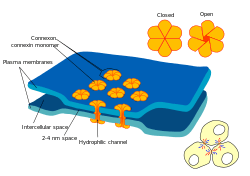Hereditary mucoepithelial dysplasia
| Hereditary mucoepithelial dysplasia | |
|---|---|
| Synonyms | Urban-Schosser-Spohn syndrome, HMD |
 Structure and location of desmosomes  Gap junctions, connecting the interior of two cells | |
| Malformation of desmosomes and gap junctions are caused in this condition | |
| Classification and external resources | |
| Specialty | dermatology |
| ICD-10 | L98.9 |
| ICD-9-CM | 709.9 |
| OMIM | 158310 |
| Orphanet | 1839 |
Hereditary mucoepithelial dysplasia (HMD), or simply mucoepithelial dysplasia,[1][2] is a rare autosomal dominant multiepithelial disorder causing systemic maldevelopment of the epithelia and mucous membranes that line the surface of tissues and structures throughout the body, particularly affecting systems affiliated with mucosa, which includes the respiratory, digestive, urinary, reproductive and immune systems.[2][3][4][5][6] The disorder is attributed to improper formation of desmosomes and gap junctions, which prevents proper cornification of the epithelial layer of the skin.[5][7]
Pathophysiology
Desmosomes are extracellular protein structures responsible for cellular adhesion, whereby cells of the same type are held closely together.[8] Gap junctions are specialized channels located within the cell membrane of many animal cell types, which serve as gateways that connect the cytoplasmic interior of two adjacent cells, allowing the passage of small molecules such as ions, nucleotides, second messengers and others.[9][10] The movement and exchange of small molecules between cells is an important part of intracellular communication processes like cell signaling.[11]
References
- ↑ Online Mendelian Inheritance in Man (OMIM) 158310
- 1 2 Bredrup, C.; Knappskog, P. M.; Majewski, J.; Rødahl, E.; Boman, H. (February 2005). "Congenital stromal dystrophy of the cornea caused by a mutation in the decorin gene" (Free full text). Invest Ophthalmol Vis Sci. 46 (2): 420–426. PMID 15671264. doi:10.1167/iovs.04-0804.
- ↑ Putran J, S. C.; Sowden, C. (October 2007). "Abnormal cervical smear in hereditary mucoepithelial dysplasia: a case report". Journal of Lower Genital Tract Disease. 11 (4): 274–275. ISSN 1089-2591. PMID 17917573. doi:10.1097/LGT.0b013e31803c4de0.
- ↑ Scheman, A.; Ray, D.; Witkop Jr, C.; Dahl, M. (Aug 1989). "Hereditary mucoepithelial dysplasia. Case report and review of the literature". Journal of the American Academy of Dermatology. 21 (2 Pt 2): 351–357. ISSN 0190-9622. PMID 2666466. doi:10.1016/S0190-9622(89)80033-7.
- 1 2 Witkop Jr, C. J.; White, J. G.; King, R. A.; Dahl, M. V.; Young, W. G.; Sauk Jr, J. J. (Jul 1979). "Hereditary mucoepithelial dysplasia: a disease apparently of desmosome and gap junction formation". American Journal of Human Genetics. 31 (4): 414–427. ISSN 0002-9297. PMC 1685894
 . PMID 484550.
. PMID 484550. - ↑ Rogers, M.; Kourt, G.; Cameron, A. (Jun 1994). "Hereditary mucoepithelial dysplasia". Pediatric Dermatology. 11 (2): 133–138. ISSN 0736-8046. PMID 8041653. doi:10.1111/j.1525-1470.1994.tb00567.x.
- ↑ Witkop Jr, C. J.; White, J. G.; Waring, G. O. (1982). "Hereditary mucoepithelial dysplasia, a disease of gap junction and desmosome formation". Birth Defects Original Article Series. 18 (6): 493–511. ISSN 0547-6844. PMID 7171771.
- ↑ Huber, O. (Sep 2003). "Structure and function of desmosomal proteins and their role in development and disease". Cellular and Molecular Life Sciences : CMLS. 60 (9): 1872–1890. ISSN 1420-682X. PMID 14523549. doi:10.1007/s00018-003-3050-7.
- ↑ Lampe, P. D.; Lau, A. F. (Jul 2004). "The effects of connexin phosphorylation on gap junctional communication". The International Journal of Biochemistry & Cell Biology (Free full text). 36 (7): 1171–1186. ISSN 1357-2725. PMC 2878204
 . PMID 15109565. doi:10.1016/S1357-2725(03)00264-4.
. PMID 15109565. doi:10.1016/S1357-2725(03)00264-4. - ↑ Lampe, P.; Lau, A. F. (Dec 2000). "Regulation of gap junctions by phosphorylation of connexins". Archives of Biochemistry and Biophysics. 384 (2): 205–215. ISSN 0003-9861. PMID 11368307. doi:10.1006/abbi.2000.2131.
- ↑ Freundlich, E.; Amit, S.; Montag, Y.; Suprun, H.; Nevo, S. (February 1972). "Familial Occurrence of Letterer-Siwe Disease". Archives of Disease in Childhood (Free full text). 47 (251): 122–125. PMC 1647995
 . PMID 5018627. doi:10.1136/adc.47.251.122.
. PMID 5018627. doi:10.1136/adc.47.251.122.